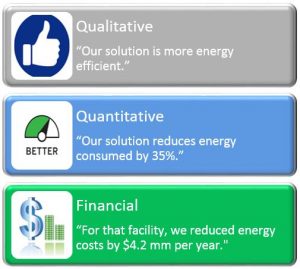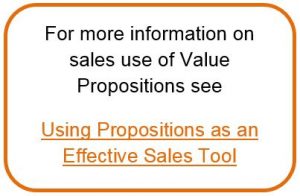Is our B2B commercial team self-centered? Or is it customer-centered?
This obvious question for any C-suite is rarely asked in public and even more rarely answered. For any self-respecting business leader, there is only one satisfactory answer. Frequently, the honest answer can be alarming, embarrassing or both.
B2B organizations designing, selling and delivering complex solutions naturally gravitate toward applying their energy and attention to themselves, focusing on the levers that they control. The telltale signs are apparent in internal discussions. “What percent of our team’s time is spent discussing our organization, our production, our logistics, our product and our services?” This internal, self-centered focus routinely spills over into customer messages and sales presentations. A product brochure highlighting technical specifications is usually the central product marketing document. All too often sales content focuses on “who are we?” and “what do we sell? Just as often sales content neglects “what are the customer’s challenges?” “how do we solve customer problems?” and “how do we deliver customer value?”
C-Suite Sponsorship – A Change in Mindset. Driving a cultural transformation from self-centered habits to customer-centric strategy is not hard to implement. It takes a change in leadership mindset and a shift in the routine, direct questions that come from the C-suite:
- Go beyond, “how does our product work?” to ask, “what does our product do for our customers?”
 Rise above the reactive, “what is our competition doing?” to ask the proactive, “what do we do better for our customers?”
Rise above the reactive, “what is our competition doing?” to ask the proactive, “what do we do better for our customers?”- Supplement questions like, “how much does our solution cost?” with clear challenges like, “how does our product deliver customer value?”
- Transcend internal and external 1-way presentations of product features with 2-way conversations that highlight customer benefits and customer value.
A Value Proposition can and should serve as a focal point that reorients an enterprise toward the Customer – the audience that matters. A Value Proposition by its nature is customer-centric, answering the fundamental question: “What do we do for our customers?”
A strong Value Proposition supports customer conversations relating to the central themes of a sales process. Why change? Why change now? Why us? Value Propositions address our differentiation in a direct way that is relevant to the customer:
- “What are the two or three things that make us better?”
- “In customer terms, how much better are we?”
- “What is that worth?”
Specific, Layered Value Propositions. A “Value Proposition” means different things to different people. For some, a Value Proposition is a non-quantitative story with clear messages and enticing images. For others, a Value Proposition is a flexible spreadsheet showing detailed assumptions and calculations of the financial case to buy our product. Most Value Propositions are somewhere in between.
Value Propositions provide core content that is useful in both internal discussions and in customer presentations. For internal discussions, Value Propositions support strategic pricing decisions, help to make product development choices and drive product launch strategy. Most external B2B sales processes involve a series of interactive customer engagements with objectives that include qualifying an account, identifying stakeholders, collaboratively supporting a customer’s buying process, obtaining a customer commitment to evaluate our solution and persuading the customer that our solution is worth the money. At most stages of the process, the objective is to move the ball down the field, not to engage in mathematical proof. But equipping sales teams to go beyond messages to numbers and financial impact is increasingly a business requirement, given the information digitally available to buyers. Buyers do the math and sales teams need to be  equipped to have the conversation. Value Propositions work best if their content is layered. As illustrated to the left, what we do for our customers can be expressed in three ways:
equipped to have the conversation. Value Propositions work best if their content is layered. As illustrated to the left, what we do for our customers can be expressed in three ways:
- Qualitative
- Quantitative
- Financial
Great Value Propositions provide content options that can be used flexibly by different users in both internal presentations for decision-making and in customer conversations to close more deals at a higher price.
Other Approaches to Customer-Centricity. Value Propositions are not the only way to reframe commercial discussions to focus on customers. Characterizing buyer personas based on customer commonalities is one approach designed to align marketing content with representative customer types. Mapping customers’ buying processes is a related method that helps to align commercial teams with the typical journey and mentality of buying teams as they make a decision to buy. Market research, increasingly bolstered by big data and digital tools, is a habit-forming customer-centric marketing practice.
Effective B2B sales trainers drive sales teams toward a customer-centric mindset. The best sales trainers have many sales prescriptions that include: (i) ask customer questions, (ii) identify customer problems, (iii) customize solutions, (iv) empower buyers, (v) satisfy needs, (vi) understand buyer fears, (vii) speak the customer’s language and (vi) demonstrate empathy. Sales trainers seek to bring these best practices to life in memorable, replicable moments in their training process to improve sales performance. This helps sales reps early and late in customer engagement. For complex sales processes, customer-centric training can help improve the effectiveness of subject matter experts, solution consultants and presales by adjusting their engagement style from one-way presentations to two-way conversations that cultivate trusted advisory relationships with customer stakeholders.
 There is no shortage of methods to reorient commercial teams toward customers. But proliferation of content and tools creates its own set of problems, drowning decision-making in data and overwhelming sales teams with content choices. The resulting commercial organization can start to resemble a chaotic collection of machine gunners instead of a disciplined team of marksmen.
There is no shortage of methods to reorient commercial teams toward customers. But proliferation of content and tools creates its own set of problems, drowning decision-making in data and overwhelming sales teams with content choices. The resulting commercial organization can start to resemble a chaotic collection of machine gunners instead of a disciplined team of marksmen.
What is Your Magic Bullet? Medical professionals aiming to treat a chronic condition search for a silver or magic bullet. For the best B2B commercial teams, a Value Proposition serves that purpose, becoming the single most important piece of customer-centric content. These teams apply Value Propositions strategically throughout a product life cycle and tactically through the course of a sales process.
- Product Development. Making a Value Proposition an integral part of a gated product development process has a
 number of benefits. It helps to transform a technology focus in product innovation into a customer focus, sustaining teams in designing their go-to-market strategy earlier in development. Value models facilitate better product positioning, better go-no go decisions and better product design decisions based on customer value created. Teams who understand their customer value early have crucial planning information to support their price and profitability assessments. Understanding value helps to drive more creative team possibilities and plans for market segments and offer design.
number of benefits. It helps to transform a technology focus in product innovation into a customer focus, sustaining teams in designing their go-to-market strategy earlier in development. Value models facilitate better product positioning, better go-no go decisions and better product design decisions based on customer value created. Teams who understand their customer value early have crucial planning information to support their price and profitability assessments. Understanding value helps to drive more creative team possibilities and plans for market segments and offer design. - Product Launch. Commercial leaders recognize the importance of Value Propositions to successful product launches. In a survey by Altify, executives identified
 Value Proposition quality as the number one reason for both product launch successes and product launch failures. A strong Value Proposition supports better product launch decisions. Value Propositions support confident selling and are an efficient way for marketing and sales teams to understand what a new product delivers for the customer.
Value Proposition quality as the number one reason for both product launch successes and product launch failures. A strong Value Proposition supports better product launch decisions. Value Propositions support confident selling and are an efficient way for marketing and sales teams to understand what a new product delivers for the customer. - Sales Team Execution. The best B2B enterprises deploy Value Propositions to improve B2B sales team performance, addressing sales challenges throughout the B2B sales cycle. For account executives and sales reps,
 Value Propositions are useful early in the sales cycle as Flexible Case Studies in call preparation, in building sales confidence, in qualifying opportunities and in engaging customer executives. For solution consultants, subject matter experts and presales professionals, joining the team in the middle of the sales process, Value Propositions provide Customer Value Analyses as an important way to address presales challenges. As customers decide to purchase, the Value Proposition becomes a Shared Business Case, collaboratively agreed between sales executives and customer
Value Propositions are useful early in the sales cycle as Flexible Case Studies in call preparation, in building sales confidence, in qualifying opportunities and in engaging customer executives. For solution consultants, subject matter experts and presales professionals, joining the team in the middle of the sales process, Value Propositions provide Customer Value Analyses as an important way to address presales challenges. As customers decide to purchase, the Value Proposition becomes a Shared Business Case, collaboratively agreed between sales executives and customer  sponsors that serve as a buyer’s internal financial justification to purchase.
sponsors that serve as a buyer’s internal financial justification to purchase.
It isn’t difficult to start value selling. CRM data from organizations adopting value selling show that opportunities where a Value Proposition is used have 5-15% higher win rates and 5-25% higher price outcomes.
Value Propositions provide core customer-centric content that helps B2B teams understand and communicate what our solution does for our customers. Value Propositions provide a shared basis for collaboration that help commercial teams win.

